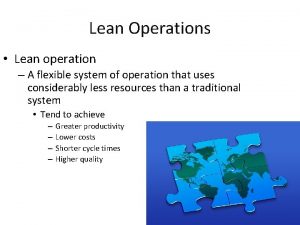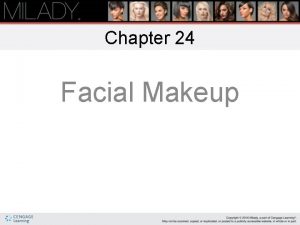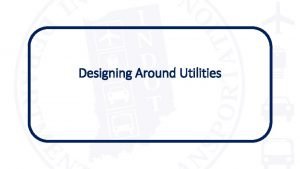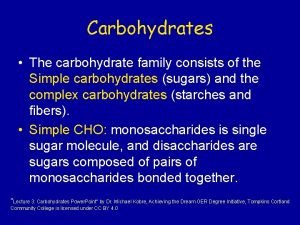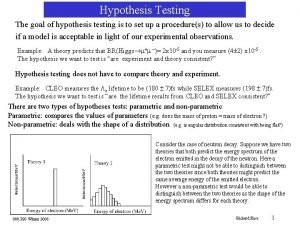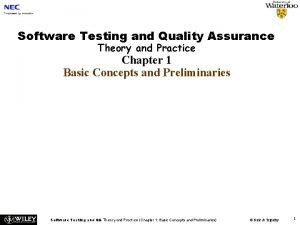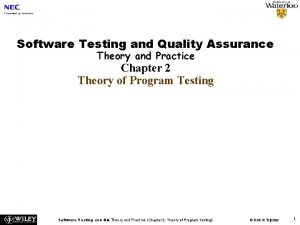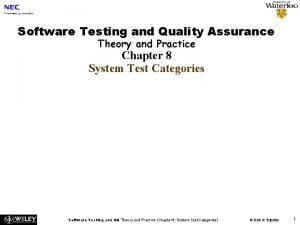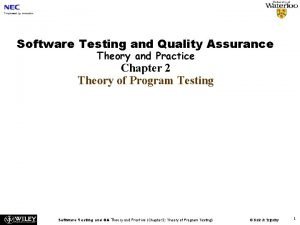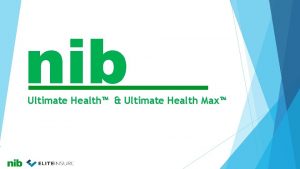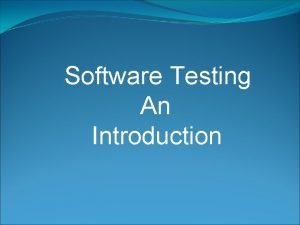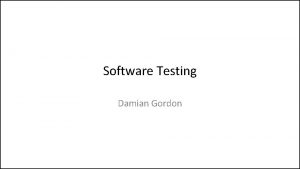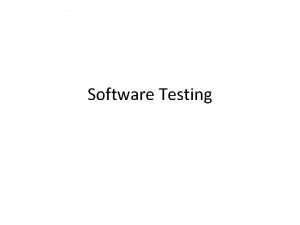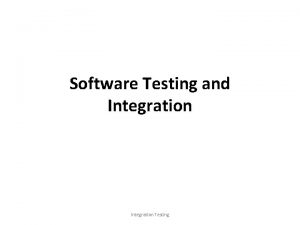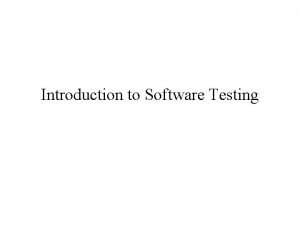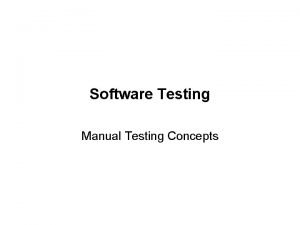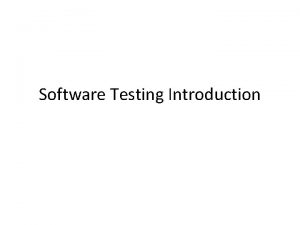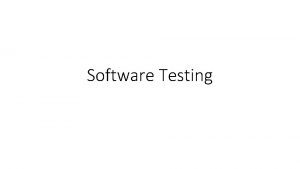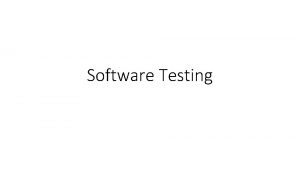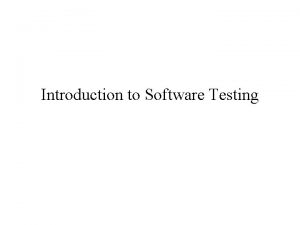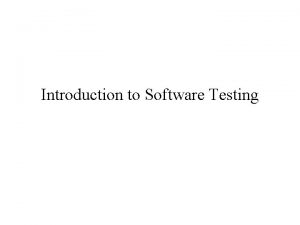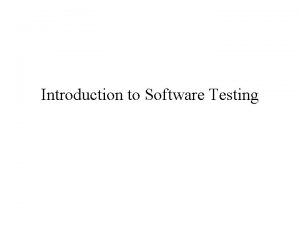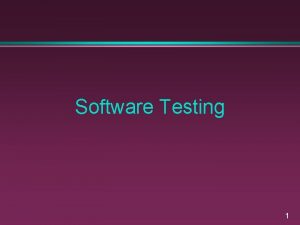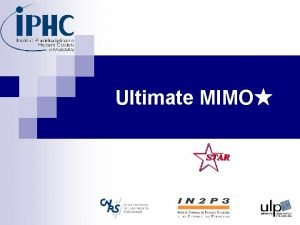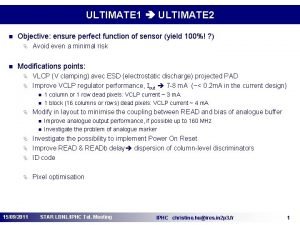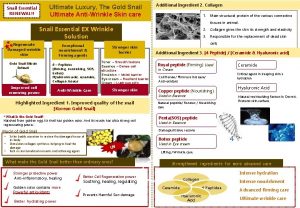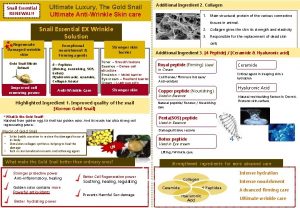Software Testing and Analysis Ultimate goal for software



















































![White box testing - binary search example int search ( int key, int [] White box testing - binary search example int search ( int key, int []](https://slidetodoc.com/presentation_image/db5108af7ceaefb7c49eeb28038e6aa1/image-52.jpg)
















- Slides: 68

Software Testing and Analysis

Ultimate goal for software testing Quality Assurance

V & V goals • Verification and validation should establish confidence that the software is fit for purpose • This does NOT mean completely free of defects • Rather, it must be good enough for its intended use and the type of use will determine the degree of confidence that is needed

Verification vs. validation • Verification: The software should conform to its specification (Are we building the product right? ) • Validation: The software should do what the user really requires (Are we building the right product? )

“Classical” lifecycle model • • Requirements Phase Specification Phase (Analysis) Planning Phase Design Phase Implementation Phase Integration and Testing Maintenance Retirement

Cost to fix faults 60* to 100* 1. 5* to 6* Cost 1* Definition Development Post Release

The V & V process • Is a whole life-cycle process - V & V must be applied at each stage in the software process. • Has two principal objectives – The discovery of defects in a system – The assessment of whether or not the system is usable in an operational situation.

Sequential model Maintenance

Static and dynamic verification • Software inspections and walkthroughs - Concerned with analysis of the static system representation to discover problems (static verification) • Software testing - Concerned with exercising and observing product behaviour (dynamic verification) – The system is executed with test data and its operational behaviour is observed

Static and dynamic V&V

V & V planning • Careful planning is required to get the most out of testing and inspection processes • Planning should start early in the development process • The plan should identify the balance between static verification and testing • Test planning is about defining standards for the testing process rather than describing product tests

The V-model of development

The structure of a software test plan • • The testing process Requirements traceability Tested items Testing schedule Test recording procedures Hardware and software requirements Constraints

Walkthroughs • Informal examination of a product (document) • Made up of: – – developers client next phase developers Software Quality Assurance group leader • Produces: – list of items not understood – list of items thought to be incorrect

Software inspections • Involve people examining the source representation with the aim of discovering anomalies and defects • Do not require execution of a system so may be used before implementation • May be applied to any representation of the system (requirements, design, test data, etc. ) • Very effective technique for discovering errors

Inspection success • Many different defects may be discovered in a single inspection. In testing, one defect may mask another so several executions are required • The reuse domain and programming knowledge so reviewers are likely to have seen the types of error that commonly arise

Inspections and testing • Inspections and testing are complementary and not opposing verification techniques • Both should be used during the V & V process • Inspections can check conformance with a specification but not conformance with the customer’s real requirements • Inspections cannot check non-functional characteristics such as performance, usability, etc.

Program inspections • Formalised approach to document reviews • Intended explicitly for defect DETECTION (not correction) • Defects may be logical errors, anomalies in the code that might indicate an erroneous condition (e. g. an un-initialised variable) or non-compliance with standards

Inspection pre-conditions • A precise specification must be available • Team members must be familiar with the organisation standards • Syntactically correct code must be available • An error checklist should be prepared • Management must accept that inspection will increase costs early in the software process • Management must not use inspections for staff appraisal

Inspection procedure • System overview presented to inspection team • Code and associated documents are distributed to inspection team in advance • Inspection takes place and discovered errors are noted • Modifications are made to repair discovered errors • Re-inspection may or may not be required

Inspection teams • Made up of at least 4 members • Author of the code being inspected • Inspector who finds errors, omissions and inconsistencies • Reader who reads the code to the team • Moderator who chairs the meeting and notes discovered errors • Other roles are Scribe and Chief moderator

Inspection checklists • Checklist of common errors should be used to drive the inspection • Error checklist is programming language dependent • The 'weaker' the type checking, the larger the checklist • Examples: Initialization, Constant naming, loop termination, array bounds, etc.

Inspection rate • 500 statements/hour during overview • 125 source statement/hour during individual preparation • 90 -125 statements/hour can be inspected • Inspection is therefore an expensive process • Inspecting 500 lines costs about 40 man/hours effort (@ $50/hr = $2000!!!)

Program testing • Can reveal the presence of errors NOT their absence • A successful test is a test which discovers one or more errors • The only validation technique for non-functional requirements • Should be used in conjunction with static verification to provide full V&V coverage

Execution based testing • “Program testing can be a very effective way to show the presents of bugs but is hopelessly inadequate for showing their absence” [Dijkstra] • Fault: “bug” incorrect piece of code • Failure: result of a fault • Error: mistake made by the programmer/developer

Testing and debugging • Defect testing and debugging are distinct processes • Verification and validation is concerned with establishing the existence of defects in a program • Debugging is concerned with locating and repairing these errors • Debugging involves formulating a hypothesis about program behaviour then testing these hypotheses to find the system error

The debugging process

Testing phases

Testing phases • Component testing – Testing of individual program components – Usually the responsibility of the component developer (except sometimes for critical systems) – Tests are derived from the developer’s experience • Integration testing – Testing of groups of components integrated to create a system or sub-system – The responsibility of an independent testing team – Tests are based on a system specification

Testing priorities • Only exhaustive testing can show a program is free from defects. However, exhaustive testing is impossible • Tests should exercise a system's capabilities rather than its components • Testing old capabilities is more important than testing new capabilities • Testing typical situations is more important than boundary value cases

Test data and test cases • Test data Inputs which have been devised to test the system • Test cases Inputs to test the system and the predicted outputs from these inputs if the system operates according to its specification

Development of test cases • Test cases and test scenarios comprise much of a software systems testware. • Black box test cases are developed by domain analysis and examination of the system requirements and specification. • Glass box test cases are developed by examining the behavior of the source code.

The defect testing process

Methods of testing • Test to specification: – – Black box, Data driven Functional testing Code is ignored: only use specification document to develop test cases • Test to code: – Glass box/White box – Logic driven testing – Ignore specification and only examine the code.

Can you guarantee a program is correct? • This is called the Halting Problem • Write a program to test if any given program is correct. The output is correct or incorrect. • Test this program on itself. • If output is incorrect, then how do you know the output is correct? • Conundrum, Dilemma, or Contradiction?

Black-box testing • An approach to testing where the program is considered as a ‘black-box’ • The program test cases are based on the system specification • Test planning can begin early in the software process

Black-box testing

Pairing down test cases • Use methods that take advantage of symmetries, data equivalencies, and independencies to reduce the number of necessary test cases. – Equivalence Testing – Boundary Value Analysis • Determine the ranges of working system • Develop equivalence classes of test cases • Examine the boundaries of these classes carefully

Equivalence partitioning • Input data and output results often fall into different classes where all members of a class are related • Each of these classes is an equivalence partition where the program behaves in an equivalent way for each class member • Test cases should be chosen from each partition

Equivalence partitioning

Boundary value testing • Partition system inputs and outputs into ‘equivalence sets’ – If input is a 5 -digit integer between 10, 000 and 99, 999, equivalence partitions are < 10, 000, 10, 000 - 99, 999 and > 10, 000 • Choose test cases at the boundary of these sets – 00000, 09999, 10000, 99999, 10001

Equivalence partitions

Search routine specification procedure Search (Key : ELEM ; T: ELEM_ARRAY; Found : in out BOOLEAN; L: in out ELEM_INDEX) ; Pre-condition -- the array has at least one element T’FIRST <= T’LAST Post-condition -- the element is found and is referenced by L ( Found and T (L) = Key) or -- the element is not in the array ( not Found and not (exists i, T’FIRST >= i <= T’LAST, T (i) = Key ))

Search routine - input partitions • Inputs which conform to the pre-conditions • Inputs where a pre-condition does not hold • Inputs where the key element is a member of the array • Inputs where the key element is not a member of the array

Testing guidelines - sequences • Test software with sequences which have only a single value • Use sequences of different sizes in different tests • Derive tests so that the first, middle and last elements of the sequence are accessed • Test with sequences of zero length

Search routine - input partitions

Sorting example • Example: sort (lst, n) – Sort a list of numbers – The list is between 2 and 1000 elements • Domains: – The list has some item type (of little concern) – n is an integer value (sub-range) • Equivalence classes; – n<2 – n > 1000 – 2 <= n <= 1000

Sorting example • • What do you test? Not all cases of integers Not all cases of positive integers Not all cases between 1 and 1001 • Highest payoff for detecting faults is to test around the boundaries of equivalence classes. • Test n=1, n=2, n=1000, n=1001, and say n= 10 • Five tests versus 1000.

White-box testing • Sometime called structural testing or glass-box testing • Derivation of test cases according to program structure • Knowledge of the program is used to identify additional test cases • Objective is to exercise all program statements (not all path combinations)

Types of structural testing • Statement coverage – Test cases which will execute every statement at least once. – Tools exist for help – No guarantee that all branches are properly tested. Loop exit? • Branch coverage – All branches are tested once • Path coverage - Restriction of type of paths: – Linear code sequences – Definition/Use checking (all definition/use paths) – Can locate dead code

White-box testing
![White box testing binary search example int search int key int White box testing - binary search example int search ( int key, int []](https://slidetodoc.com/presentation_image/db5108af7ceaefb7c49eeb28038e6aa1/image-52.jpg)
White box testing - binary search example int search ( int key, int [] elem. Array) { int bottom = 0; int top = elem. Array. length - 1; int mid; int result = -1; while ( bottom <= top ) { mid = (top + bottom) / 2; if (elem. Array [mid] == key) { result = mid; return result; } // if part else { if (elem. Array [mid] < key) bottom = mid + 1; else top = mid - 1; } } //while loop return result; } // search

Binary search equivalence partitions • Pre-conditions satisfied, key element in array • Pre-conditions satisfied, key element not in array • Pre-conditions unsatisfied, key element not in array • Input array has a single value • Input array has an even number of values • Input array has an odd number of values

Binary search equivalence partitions

Binary search - test cases

Path testing • The objective of path testing is to ensure that the set of test cases is such that each path through the program is executed at least once • The starting point for path testing is a program flow graph that shows nodes representing program decisions and arcs representing the flow of control • Statements with conditions are therefore nodes in the flow graph

Program flow graphs • Describes the program control flow. Each branch is shown as a separate path and loops are shown by arrows looping back to the loop condition node • Used as a basis for computing the cyclomatic complexity • Cyclomatic complexity = Number of edges Number of nodes +2

Cyclomatic complexity • The number of tests to test all control statements equals the cyclomatic complexity • Cyclomatic complexity equals number of conditions in a program • Useful if used with care. Does not imply adequacy of testing • Although all paths are executed, all combinations of paths are not executed

Binary search flow graph

Independent paths • • • 1, 2, 3, 8, 9 1, 2, 3, 4, 6, 7, 2 1, 2, 3, 4, 5, 7, 2 1, 2, 3, 4, 6, 7, 2, 8, 9 Test cases should be derived so that all of these paths are executed • A dynamic program analyser may be used to check that paths have been executed

Feasibility • Pure black box testing (specification) is realistically impossible because there are (in general) too many test cases to consider. • Pure testing to code requires a test of every possible path in a flow chart. This is also (in general) infeasible. Also every path does not guarantee correctness. • Normally, a combination of Black box and Glass box testing is done.

Integration testing • Tests complete systems or subsystems composed of integrated components • Integration testing should be black-box testing with tests derived from the specification • Main difficulty is localising errors • Incremental integration testing reduces this problem

Incremental integration testing

Approaches to integration testing • Top-down testing – Start with high-level system and integrate from the top-down replacing individual components by stubs where appropriate • Bottom-up testing – Integrate individual components in levels until the complete system is created • In practice, most integration involves a combination of these strategies

Top-down testing

Bottom-up testing

Software testing metrics • • Defects rates Errors rates Number of errors found person hours expended • Measured by: – individual – module – during development • Errors should be categorized by origin, type, cost

More metrics • Direct measures - cost, effort, LOC, etc. • Indirect Measures - functionality, quality, complexity, reliability, maintainability • Size Oriented: – – – Lines of code - LOC Effort - person months errors/KLOC defects/KLOC cost/KLOC
 Final goal of buddhism
Final goal of buddhism The ultimate goal of lean operations is to have
The ultimate goal of lean operations is to have 83kgs to stone
83kgs to stone Protruding or bulging eyes can be minimized by:
Protruding or bulging eyes can be minimized by: What is the ultimate goal of a designer
What is the ultimate goal of a designer Carbohydrates family
Carbohydrates family Domain testing example
Domain testing example Motivational overview of logic based testing
Motivational overview of logic based testing Du path testing
Du path testing Localization globalization testing
Localization globalization testing Language testing
Language testing Control structure testing in software engineering
Control structure testing in software engineering Decision table testing in software testing
Decision table testing in software testing Decision table based testing
Decision table based testing Extended decision table
Extended decision table Rigorous testing in software testing
Rigorous testing in software testing Testing blindness in software testing
Testing blindness in software testing Software domain examples
Software domain examples Cs 527
Cs 527 Otto hoffman by product oven diagram
Otto hoffman by product oven diagram Goal of hypothesis testing
Goal of hypothesis testing Positive testing and negative testing
Positive testing and negative testing Cs 3250
Cs 3250 Functional testing vs unit testing
Functional testing vs unit testing Blackbox testing adalah
Blackbox testing adalah Behavioral testing adalah
Behavioral testing adalah Component testing is a black box testing
Component testing is a black box testing Quality assurance theory
Quality assurance theory Software testing and quality assurance: theory and practice
Software testing and quality assurance: theory and practice Software testing and quality assurance theory and practice
Software testing and quality assurance theory and practice Software testing and quality assurance theory and practice
Software testing and quality assurance theory and practice Software testing and quality assurance theory and practice
Software testing and quality assurance theory and practice Kontinuitetshantering
Kontinuitetshantering Typiska drag för en novell
Typiska drag för en novell Tack för att ni lyssnade bild
Tack för att ni lyssnade bild Ekologiskt fotavtryck
Ekologiskt fotavtryck Varför kallas perioden 1918-1939 för mellankrigstiden?
Varför kallas perioden 1918-1939 för mellankrigstiden? En lathund för arbete med kontinuitetshantering
En lathund för arbete med kontinuitetshantering Underlag för särskild löneskatt på pensionskostnader
Underlag för särskild löneskatt på pensionskostnader Vilotidsbok
Vilotidsbok A gastrica
A gastrica Förklara densitet för barn
Förklara densitet för barn Datorkunskap för nybörjare
Datorkunskap för nybörjare Boverket ka
Boverket ka Mall debattartikel
Mall debattartikel Delegerande ledarstil
Delegerande ledarstil Nyckelkompetenser för livslångt lärande
Nyckelkompetenser för livslångt lärande Påbyggnader för flakfordon
Påbyggnader för flakfordon Lufttryck formel
Lufttryck formel Offentlig förvaltning
Offentlig förvaltning Bo bergman jag fryser om dina händer
Bo bergman jag fryser om dina händer Presentera för publik crossboss
Presentera för publik crossboss Teckenspråk minoritetsspråk argument
Teckenspråk minoritetsspråk argument Bat mitza
Bat mitza Klassificeringsstruktur för kommunala verksamheter
Klassificeringsstruktur för kommunala verksamheter Fimbrietratt
Fimbrietratt Claes martinsson
Claes martinsson Cks
Cks Verifikationsplan
Verifikationsplan Mat för idrottare
Mat för idrottare Verktyg för automatisering av utbetalningar
Verktyg för automatisering av utbetalningar Rutin för avvikelsehantering
Rutin för avvikelsehantering Smärtskolan kunskap för livet
Smärtskolan kunskap för livet Ministerstyre för och nackdelar
Ministerstyre för och nackdelar Tack för att ni har lyssnat
Tack för att ni har lyssnat Vad är referatmarkeringar
Vad är referatmarkeringar Redogör för vad psykologi är
Redogör för vad psykologi är Borstål, egenskaper
Borstål, egenskaper Atmosfr
Atmosfr

